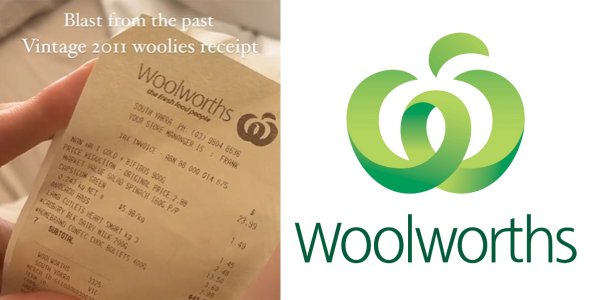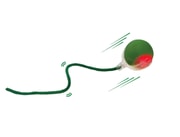Comparing a Decade-Old Grocery Receipt to Today's Prices: The Shocking Reality of Rising Costs
By
- Replies 7
As we grapple with the ever-rising cost of living, many of us yearn for a simpler way of life.
But when one Australian mum found an old Woolworths receipt from over a decade ago, it wasn't just the nostalgia that gave her a jolt.
The woman, who wishes to remain anonymous, stumbled upon the 'vintage' docket in the pocket of a jacket she hadn't worn since 2011.
She was initially shocked at the 'price of meat' before realising she had been reading the word wrong, and it was 'about the same price' as what she currently pays today.
But it was when other details on the docket were compared to like-for-like items available at supermarkets today that really revealed the price increases over the past 12 years.

However, some shoppers noticed that certain items had significantly increased in price and decreased in size over the past 12 years — a phenomenon known as ‘shrinkflation’.
Baby formula is the first item on the bill, and it, unfortunately, comes as no surprise that each can is now 100 grams smaller than when the docket was first printed.
'A weekly essential for some parents would blow my budget these days,' the mum wrote.
Chocolate is another everyday luxury that has gone up in price.
'Cadbury is now 180 grams and $5.50,' one woman commented.
The weekly purchase of avocados was still 'about the same', but other fresh produce, like capsicums and hass avocado, had gone up in price.
And as for the case of the meat prices not changing too much, it must be noted that back in 2011, the cost of lamb experienced a significant surge, surpassing that of beef for the very first time.
Alarming forecasts predicted it would reach $100 per kilo by 2012.
However, in 2023, the price of lamb dropped due to an increase in supply, which could explain why the cost of lamb cutlets isn't vastly different.
Upon conducting a thorough comparison of her 2011 purchases to similar products available today, she discovered that the overall cost of the items had increased by just over 39 per cent.
The groceries, which had initially cost $49.58, now amount to $73.83 in total.

There you have it, folks! This eye-opening discovery serves as a vital reminder for all of us: be mindful of where our hard-earned money is going and always compare prices to make sure we’re getting the best value for our purchases.
To provide more perspective, you might also want to read this article where we shared how one shopper discovered the price differences between goods sold in 1992 and 2023.
Have any of you ever discovered any old receipts or other objects that have surprised you? Tell us all about it in the comments below! We'd love to hear your stories.
But when one Australian mum found an old Woolworths receipt from over a decade ago, it wasn't just the nostalgia that gave her a jolt.
The woman, who wishes to remain anonymous, stumbled upon the 'vintage' docket in the pocket of a jacket she hadn't worn since 2011.
She was initially shocked at the 'price of meat' before realising she had been reading the word wrong, and it was 'about the same price' as what she currently pays today.
But it was when other details on the docket were compared to like-for-like items available at supermarkets today that really revealed the price increases over the past 12 years.

After discovering a 2011 Woolworths receipt, a mum was surprised when comparing grocery prices from a decade ago to those of today. Credit: TikTok/@iknowtegan/Woolworths.
However, some shoppers noticed that certain items had significantly increased in price and decreased in size over the past 12 years — a phenomenon known as ‘shrinkflation’.
Baby formula is the first item on the bill, and it, unfortunately, comes as no surprise that each can is now 100 grams smaller than when the docket was first printed.
'A weekly essential for some parents would blow my budget these days,' the mum wrote.
Chocolate is another everyday luxury that has gone up in price.
'Cadbury is now 180 grams and $5.50,' one woman commented.
The weekly purchase of avocados was still 'about the same', but other fresh produce, like capsicums and hass avocado, had gone up in price.
And as for the case of the meat prices not changing too much, it must be noted that back in 2011, the cost of lamb experienced a significant surge, surpassing that of beef for the very first time.
Alarming forecasts predicted it would reach $100 per kilo by 2012.
However, in 2023, the price of lamb dropped due to an increase in supply, which could explain why the cost of lamb cutlets isn't vastly different.
Upon conducting a thorough comparison of her 2011 purchases to similar products available today, she discovered that the overall cost of the items had increased by just over 39 per cent.
The groceries, which had initially cost $49.58, now amount to $73.83 in total.
Key Takeaways
- An Australian mum found an old Woolworths receipt from over a decade ago and compared prices to current ones.
- Some items, like baby formula and chocolate, have significantly increased in price and decreased in size over the past 12 years.
- The price of meat has not changed significantly since 2011 due to fluctuations in supply and demand.
- The overall cost of the items on the old receipt increased by just over 39 per cent, with the groceries that initially cost $49.58 now totalling $73.83.
There you have it, folks! This eye-opening discovery serves as a vital reminder for all of us: be mindful of where our hard-earned money is going and always compare prices to make sure we’re getting the best value for our purchases.
To provide more perspective, you might also want to read this article where we shared how one shopper discovered the price differences between goods sold in 1992 and 2023.
Have any of you ever discovered any old receipts or other objects that have surprised you? Tell us all about it in the comments below! We'd love to hear your stories.








